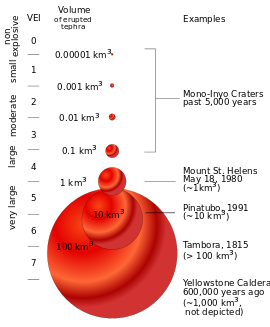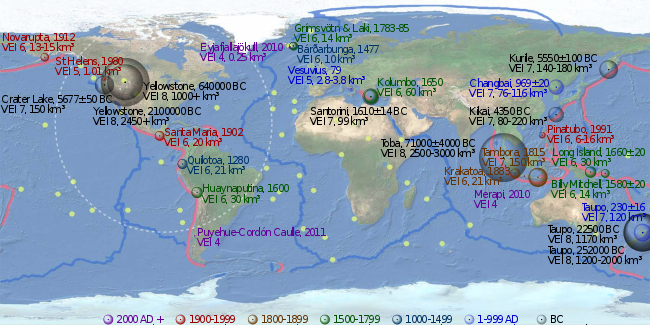火山爆發指數...
火山学
美國地質調查局克里斯·紐豪爾夏威夷大學馬諾阿分校斯蒂芬·塞爾夫火山爆發奧陶紀更新世

火山爆發指數(VEI)與噴出物體積的关系。
火山爆發指數(Volcanic Explosivity Index,簡稱VEI)是1982年美國地質調查局(USGS)的克里斯·紐豪爾教授(Chris Newhall)和夏威夷大學馬諾阿分校的斯蒂芬·塞爾夫提出的量表,以噴出物體積、火山雲和定性觀測用來量度火山爆發的強烈程度。
火山爆發指數採用開放式尺度,歷史上最大型的火山爆發強度為8級,而非爆炸性噴發強度為0級,指數每增1級表示火山爆發威力大10倍。在奧陶紀與更新世之間發生的已发现的火山爆發指數8級的火山爆發共有47次,其中42次在過去3,600萬年內發生,最近一次是在26,500年前發生的陶波火山爆發。[1]
目录
1 分級
2 另見
3 參考文獻
4 外部連結
分級
| 火山爆發指數 | 噴出物體積 | 分類 | 描述 | 熱柱 | 頻率 | 例子 | 過去10,000年發生次數* |
|---|---|---|---|---|---|---|---|
| 0 | < 10,000 m³ | 夏威夷式 | non-explosive | < 100 m | 持續 | 冒納羅亞火山 | 很多 |
| 1 | > 10,000 m³ | 夏威夷式/斯通波利式 | gentle | 100-1000 m | 每天 | 斯特龍博利島 | 很多 |
| 2 | > 1,000,000 m³ | 斯通波利式/伏爾坎寧式 | explosive | 1-5 km | 每週 | 加勒拉斯火山 (1993) | 3,477 |
| 3 | > 10,000,000 m³ | 伏爾坎寧式/培雷式 | severe | 3-15 km | 每年 | Cordón Caulle (1921) | 868 |
| 4 | > 0.1 km³ | 培雷式/普林尼式 | cataclysmic | 10-25 km | ≥ 10年 | 艾雅法拉火山 (2010) | 421 |
| 5 | > 1 km³ | 普林尼式 | paroxysmal | > 25 km | ≥ 50年 | 聖海倫斯火山 (1980) | 166 |
| 6 | > 10 km³ | 普林尼式/超普林尼式 | colossal | > 25 km | ≥ 100年 | 喀拉喀托火山 (1883)、於埃納普蒂納火山 (1600)、皮納圖博火山(1991) | 51 |
| 7 | > 100 km³ | 普林尼式/超普林尼式 | super-colossal | > 25 km | ≥ 1,000年 | 坦博拉火山 (1815)、米諾斯火山爆發 | 5 (+疑似2) |
| 8 | > 1,000 km³ | 超普林尼式 | mega-colossal | > 25 km | ≥ 10,000年 | 陶波火山 (25,360 BC)、多峇火山 (74,000 BC)、黃石火山(630,000 BC) | 0 |
| 火山爆發指數 | 噴出物體積 | 分類 | 描述 | 熱柱 | 頻率 | 對流層 注入 | 平流層 注入[2] |
|---|---|---|---|---|---|---|---|
| 例子 | |||||||
| 0 | < 104 m3 | Hawaiian | Effusive | < 100 m | continuous | negligible | none |
Hoodoo Mountain (c. 7050 BC),[3]Erebus (1963), Kīlauea (1977), Socorro Island (1993), Mawson Peak (2006), Dallol (2011), Piton de la Fournaise (2017) | |||||||
1 | > 104 m3 | Hawaiian / Strombolian | Gentle | 100 m – 1 km | daily | minor | none |
Stromboli (since Roman times), Nyiragongo (2002), Raoul Island (2006) | |||||||
2 | > 106 m3 | Strombolian / Vulcanian | Explosive | 1–5 km | every two weeks | moderate | none |
Unzen (1792), Cumbre Vieja (1949), Galeras (1993), Sinabung (2010) | |||||||
3 | > 107 m3 | Vulcanian / Peléan/Sub-Plinian | Catastrophic | 3–15 km | 3 months | substantial | possible |
Lassen Peak (1915), Nevado del Ruiz (1985), Soufrière Hills (1995), Ontake (2014) | |||||||
4 | > 0.1 km3 | Peléan / Plinian/Sub-Plinian | Cataclysmic | > 10 km (Plinian or sub-Plinian) | 18 months | substantial | definite |
Laki (1783), Kīlauea (1790), Mayon (1814), Pelée (1902), Colima (1913), Sakurajima (1914), Katla (1918), Galunggung (1982), Eyjafjallajökull (2010), Nabro (2011), Calbuco (2015) | |||||||
5 | > 1 km3 | Peléan/Plinian | Paroxysmic | > 10 km (Plinian) | 12 years | substantial | significant |
Vesuvius (79), Fuji (1707), Tarawera (1886), Agung (1963), St. Helens (1980), El Chichón (1982), Hudson (1991), Puyehue (2011) | |||||||
6 | > 10 km3 | Plinian / Ultra-Plinian | Colossal | > 20 km | 50–100 yrs | substantial | substantial |
Laach Lake Volcano (c. 12,900 BC), Nevado de Toluca (10,500 BP), Veniaminof (c. 1750 BC), Lake Ilopango (450), Ceboruco (930), Huaynaputina (1600), Krakatoa (1883), Santa Maria (1902), Novarupta (1912), Pinatubo (1991) | |||||||
7 | > 100 km3 | Ultra-Plinian | Super-colossal | > 20 km | 500–1,000 yrs | substantial | substantial |
Aira Caldera (22,000 BC), Kikai Caldera (4,300 BC), Cerro Blanco (c. 2300 BC), Thera (c. 1620 BC), Taupo (180), Baekdu (946), Samalas (1257), Tambora (1815) | |||||||
8 | > 1000 km3 | Ultra-Plinian | Mega-colossal | > 20 km | > 50,000 yrs[4][5] | vast | vast |
La Garita (26,300,000 BC), Cerro Galán (2,200,000 BC), Huckleberry Ridge Tuff (2,100,000 BC), Yellowstone (630,000 BC), Whakamaru (in TVZ) (254,000 BC),[6]Toba (74,000 BC), Taupo (25,360 BC) | |||||||
另見

每個氣泡的表觀體積與噴出的火山灰的體積成線性比例,按照圖例中的噴發時間進行顏色編碼。粉色線表示聚合邊界,藍色線表示張裂邊界,黃色斑點表示熱點。
- 超級火山
參考文獻
^ Mason, Ben G.; Pyle, David M.; Oppenheimer, Clive. The size and frequency of the largest explosive eruptions on Earth. Bulletin of Volcanology. 2004, 66 (8): 735–748. doi:10.1007/s00445-004-0355-9. 引文使用过时参数coauthors (帮助)
^
Volcanic Explosivity Index (VEI). Global Volcanism Program. Smithsonian National Museum of Natural History. [August 21, 2014]. (原始内容存档于November 10, 2011).
^ https://volcano.si.edu/volcano.cfm?vn=320080
^ Dosseto, A. Turner, S. P.; Van-Orman, J. A., 编. Timescales of Magmatic Processes: From Core to Atmosphere. Wiley-Blackwell. 2011. ISBN 978-1-4443-3260-5. 缺少或|url=为空 (帮助)
^ Rothery, David A. Volcanoes, Earthquakes and Tsunamis. Teach Yourself. 2010. 缺少或|url=为空 (帮助)
^ Froggatt, P. C.; Nelson, C. S.; Carter, L.; Griggs, G.; Black, K. P. An exceptionally large late Quaternary eruption from New Zealand. Nature. 13 February 1986, 319 (6054): 578–582 [23 August 2010]. Bibcode:1986Natur.319..578F. doi:10.1038/319578a0.
.mw-parser-output .refbegin{font-size:90%;margin-bottom:0.5em}.mw-parser-output .refbegin-hanging-indents>ul{list-style-type:none;margin-left:0}.mw-parser-output .refbegin-hanging-indents>ul>li,.mw-parser-output .refbegin-hanging-indents>dl>dd{margin-left:0;padding-left:3.2em;text-indent:-3.2em;list-style:none}.mw-parser-output .refbegin-100{font-size:100%}
Newhall, Christopher G.; Self, Steve. The volcanic explosivity index (VEI): An estimate of explosive magnitude for historical volcanism. Journal of Geophysical Research. 1982, 87 (C2): 1231–1238. doi:10.1029/JC087iC02p01231. 引文使用过时参数coauthors (帮助)
外部連結
VEI glossary entry from a United States Geological Survey website
How to measure the size of a volcanic eruption, from The Guardian
The size and frequency of the largest explosive eruptions on Earth, a 2004 article from the Bulletin of Volcanology
- List of Large Holocene Eruptions (VEI > 4) from the Smithsonian Global Volcanism Program
VEI (Volcanic Explosivity Index) from the Global Volcanism Program of the Smithsonian National Museum of Natural History